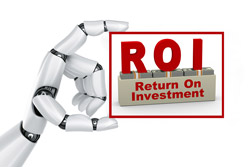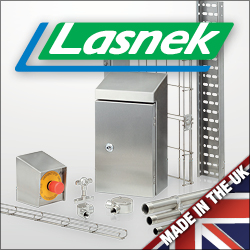
Posted to News on 29th Jan 2015, 19:18
Automation payback - 10 tips for achieving ROI in 12 months
Machine builders and suppliers of automation equipment often talk about how their machines deliver optimum performance, boost workplace efficiency and increase output. However, for most, if not all customers, the return on investment (ROI) figures can be a real deal breaker. Richard Gladwin, Technical Director at system integrator Pacepacker Services, offers 10 powerful tips that can help automation to deliver an ROI inside a year.

Richard Gladwin states: "The fact is ROI is about the whole picture. When done right, pick-and-place automation and robotics on a bagging, packing or palletising line can turn an inefficient and labour-intensive operation into a smooth, uninterrupted, cost-efficient performance. What is more, a well thought out turnkey line or robotics solution can often start paying its own way in as little as 12 months."
Whether you have a fully automated line that needs modifying or are about to take the plunge for the first time in 2015, these insightful tips from Pacepacker Services demonstrate how manufacturers in every sector can derive real value from an automation investment, whatever the budget.
1. Consider in depth the process you want to automate
Automated systems are consistent and predictable. However, the more flexibility you look to introduce, the more costly they can become. Always question if the add-on features, extra tools and auto-adjustment capabilities are a business priority. If not now, will they be utilised in the future? Look at ways of simplifying the process so that the operations can be reproduced easily and within budget.
2. Can the system be adapted and modified in the future?
There is a misconception that automated systems fast become obsolete. Any supplier should do the utmost to future-proof the customer's investment, providing support with tooling and programming. Many systems can be adapted or upgraded to suit future requirements; many of Pacepacker's systems are still being used in excess of 20 years after installation. Work with the integrator to scope out the user requirement specifications (URS) as this will focus minds on products being handled, packaging sizes and variants, speeds, etc.
3. Plan out the space and test automation concepts
Designs need to be practical and workable. A simulated drawing, such as CAD, will identify space restrictions and also enable floor space to be optimised. There are also programs to model the different robotic movements and variables before actual build. At Pacepacker, we offer a Try Before You Buy service, giving customers the opportunity to test systems using their own products. This assists everyone to scope out and refine the design before an actual order is placed and installed.
4. Do the maths
Total cost of ownership (TCO) and ROI are frequently confused. However, both can be used together to analyse the long-term value to the business. TCO denotes more than the direct cost of purchasing and implementing a system. It also includes services, maintenance and other indirect costs, and takes into account the full cost of an asset over its useful life. A well-engineered system will provide a low cost of ownership and provide many years of service at a fraction of the cost of manual labour. But cheaply made, under-engineered equipment may prove costly in the long run.
5. Pay attention to the benefits of automation

6. Look beyond the people
Other benefits of automation are lower product and packaging wastage, and enhanced quality, which can significantly affect the business and brand reputation. Also, examine any potential production bottlenecks. If some of the new equipment, such as a weighing system, is working faster than the bagging or palletising parts of the line, the benefits may be reduced.
7. Protect the investment
Machine downtime can significantly impact the production flow, especially where there are interdependencies. Today's systems are robust and reliable, running smoothly 99 per cent of the time. Nevertheless, much like fine-tuning a car, preventative maintenance plans are proven to decrease breakdowns and prevent costly business interruptions. Remote diagnostics are becoming widely available and can be a value-added service. For instance, many Pacepacker systems are built to enable them to be fitted with remote diagnostics.
8. Develop in-house engineering skills
It is worth customers investing in some training, ensuring the engineers have the on-site skills to provide quick fixes. They will also be able to observe when the machinery may not be performing as efficiently as normal and take action before the issue becomes serious.
9. Research the automation partner well
Investing in end-of-line automation is one of the biggest decisions a business can make, and should also be the best. Look for a provider that understands the sector, offers a wide variety of options, with a proven track record in automation. It is not purely about the machine, but having access to a customised system, including ongoing service, support, training and upgrade routes. Those offering purely standard products may result in the customer overpaying for a faster system with add-ons that may never be used.
10. Stay ahead of the competition
The next decade looks set to be a challenging one for manufacturers. Manufactures must avoid falling behind competitors, missing critical business opportunities or losing industry influence. Shorter time to market, quality, efficiency, retail squeeze on profit margins and sustainability are all key trends. Like Europe, emerging markets and Asia are swiftly recognising the benefits of automation and investing now. UK-based machine builders and integrators continue to lead the way in creating world-class automation systems to boost our economy, as well as maintaining our British engineering skills and manufacturing heritage. With careful planning, a 12-month ROI is attainable, meaning that now is the right time to explore automation options.
To learn more about automation systems please go to www.pacepacker.com.
X
X
GLOBAL


















